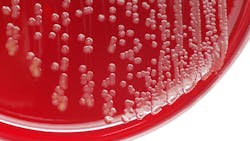Bacteria research may lead to new infection treatments
“Know thy self; know thy enemy” – Sun Tzu
That quote is from centuries ago, but it is applicable in so many ways. One example – new research from Nova Southeastern University (NSU) is understanding human infections and unlocking how bacteria “work together” making these infections much more difficult to treat. But it is understanding this symbiotic relationship – knowing thy enemy – that can lead to better ways to treat various ailments. This study was recently published by the scientific journal eLife.
“There are good bacteria and not-so-good bacteria,” said Robert Smith, PhD, and Associate Professor and Research Scientist, Cell Therapy Institute in NSU’s Kiran Patel College of Allopathic Medicine (NSU MD). “Bacteria are all around us, with some providing beneficial aspects to life, but there are others that cause infections or worsen illnesses.”
Smith was the principal investigator on a research team that looked at how bacteria may work together, exacerbating illness and making treatment more difficult. Specifically, they looked at two bacteria that are commonly found together in infections – Staphylococcus aureus and Pseudomonas aeruginosa. Staph can be found on the skin of around 50% of the population; Pseudomonas can be found in the soil. However, when they get together in infections, things can get bad.
“Most infections are caused by a single bacterium, but when bacterial species ‘gang up’, they can become even more challenging to treat,” Smith said. “The infection is more severe, and they can resist antibiotic treatment.”
According to Smith, these bacteria communicate in the wound, causing the infection to be more severe and challenging to treat. This is particularly important in individuals with cystic fibrosis where these two bacteria thrive.
“Towards trying to develop new ways to treat infection with these bacteria, we found that how fast each bacteria grows and how much energy each bacteria has determines how they talk to each other in the wound,” Smith said. “If we can interrupt their ability to talk to each other, then we might be able to come up with ways to change their growth or the amount of energy they possess, which could decrease the severity of the infection and may make them more susceptible to antibiotics.”
